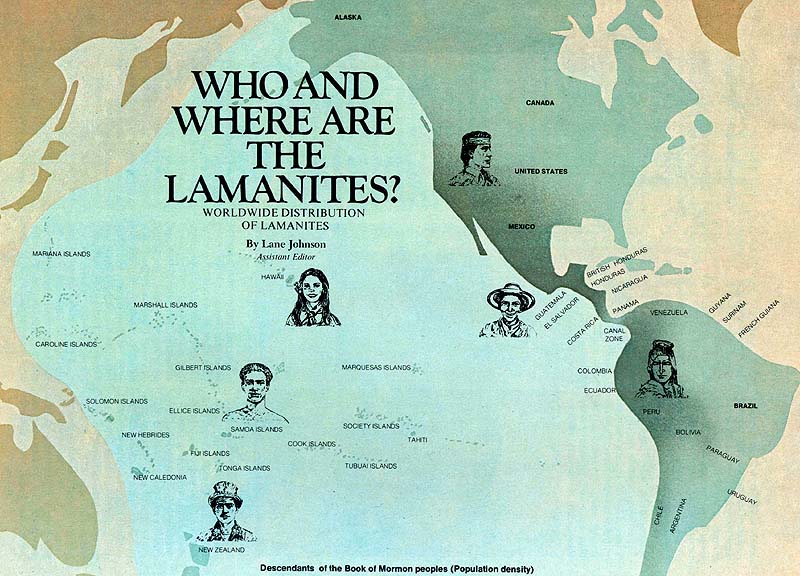“Who and Where Are the Lamanites?” Ensign, Dec. 1975, 15
Who and Where Are the Lamanites?
Worldwide Distribution of Lamanites
To produce a map that shows where the Lamanites of the world are located today, the mapmaker must first decide exactly what a Lamanite is. This turns out to be no small task, because the term Lamanite is used in several different senses in the scriptures to describe a particular racial lineage, a political/religious group, a covenant people, etc. However, the Old and New Testaments and the Book of Mormon, viewed together in one limited sense as a partial record of the peopling of the earth, provide a useful context in which to view this problem.

Descendants of the Book of Mormon peoples (Population density)
The history of the peopling of the earth is really a history of the scattering of the descendants of Noah, who is sometimes referred to as the “second father of mankind.” This general scattering began soon after the Flood when the sons of Noah and their children began to spread forth “in their lands, … after their nations” (see Gen. 10:5, 20, 31) and was greatly accelerated at the time of the Tower of Babel, when the Lord confounded the people’s language and did “scatter them abroad upon the face of all the earth.” (Gen. 11:9.)
Immediately after the description of Babel in Genesis 11, the Old Testament record moves quickly to Abraham, a descendant of Shem, and ceases thereafter to be a record of all the descendants of Noah; instead, it focuses almost entirely on the Lord’s covenant people, presumably a relatively small part of the earth’s total population at that time. We know very little about the remainder of Noah’s seed, except that in time they wandered throughout the extent of the land to become the heathen nations of the earth.
The nations of the earth had been dispersing from the Tower of Babel for 1,500 years when the Ten Tribes of Israel were carried captive into Assyria. Shortly thereafter, Judah was taken into exile by Nebuchadnezzar, and although one group was permitted to return to rebuild Jerusalem, the bulk of the kingdom of Judah remained in Babylon to be eventually dispersed. Then, in A.D. 70, the remainder of the Jews were driven from the promised land by the Romans to complete the scattering of Israel.
What we see in this brief account is a picture of the general dissemination of the descendants of Noah throughout the world, beginning at the time of the Flood, with other groups—remnants of Israel—breaking away at intervals to follow the earlier migrants to the various corners of the earth and establish themselves among them as strangers, though distantly related.
Within this broad picture we find the people of the Book of Mormon, which is a partial record of some of those who were, at various times, led out of the Old World by the Lord to become established in the American continents: the Jaredites, who were led away at the time of the Tower of Babel and were, therefore, a part of the earliest dissemination of the descendants of Noah; the Lehi colony, led out of Jerusalem during the reign of Zedekiah, just prior to the captivity of Judah by Nebuchadnezzar; and the colony of Mulek, the youngest son of Zedekiah, who departed Jerusalem eleven years after Lehi.
The term Lamanite was first applied to the literal family of Laman, Lehi’s eldest son. This name very soon took on a broader application, however, when Laman, Lemuel, and some of the sons of Ishmael rebelled against and sought to kill Nephi, in whom the Lord had vested his authority. At that time the Lord cut them off from his presence and caused a darker skin coloring to come upon them. (See 2 Ne. 5:19–21.) Thereafter the name Lamanite referred to a religious/political faction whose distinguishing feature was its opposition to the church. (See Jacob 1:13–14.) Lineage became an increasingly minor factor, and later there are many examples of Lamanites becoming Nephites and Nephites becoming Lamanites.
For nearly 200 years after the coming of Christ to the Americas, there were no Lamanites “nor any manner of -ites; but they were in one, the children of Christ, and heirs to the kingdom of God.” (4 Ne. 1:17.) Soon, however, a part of the people fell away and took upon them the name of Lamanites; “therefore there began to be Lamanites again in the land.” (4 Ne. 1:20.) Clearly, Lamanite in this case again refers to the state of righteousness of a political/religious group, presumably a composite of the descendants of many of the original colonists in the New World. The Lamanites of this definition survived beyond the close of the Book of Mormon record, and it is these people from whom the Lamanites of today descended. That is to say, they are the descendants of Lehi, Ishmael, and Zoram (see D&C 3:17–18); they are the descendants of Mulek and the others of his colony (see Hel. 6:10; Omni 1:14, 15); and they may also be descended from other groups of whom we have no record. Certainly they have mixed with many other lineages at the far reaches of their dispersal in the Americas and most of the islands of the Pacific since the time when Moroni bade them farewell in A.D. 421.
In this composite group is the blood of Israel, for we know that Lehi was of the tribe of Manasseh (see Alma 10:3), that Ishmael was of Ephraim (see JD 3:184), and that Mulek was of Judah, being a descendant of King David through Zedekiah. Therefore, the Lamanites of today—all the mixed descendants of the Book of Mormon peoples—have a legitimate claim to the blessings of the Abrahamic covenant and, in turn, the duty to now carry these blessings to those nations of the earth who yet remain in darkness, the remainder of the descendants of Noah.